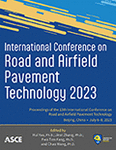Self-Healing Analyses of Asphalt Cracks under Changing Temperature Conditions through Molecular Dynamics
Publication: International Conference on Road and Airfield Pavement Technology 2023
ABSTRACT
Asphalt pavement has the potential ability of micro-crack self-healing during the rest periods, and temperature is the main influencing factor. In order to reveal the effect of changing temperature on the self-healing performance of asphalt micro-cracks by microwave heating, the crack models of asphalt binder consisting of three and four components were constructed and the molecular dynamics (MD) method was used to analyze the diffusion performance of the asphalt crack under the conditions of constant temperature and changing temperature. The mean square displacement was analyzed by the density change curve and the diffusion coefficient was obtained through determining the number of frames when the crack was self-healed. The results show that under the same temperature parameter simulation conditions, both the three and four component asphalt crack models healing efficiency of asphalt micro-cracks was the best under the constant high temperature of 373 K, followed by the changing temperature from 303 K to 373 K, and healing efficiency under the constant low temperature of 303 K was the lowest. The diffusion coefficient in the changing temperature is close to the diffusion coefficient at a constant high temperature, which is reasonably close to the self-healing efficiency of both. The improved simulation method can better describe the diffusion ability of asphalt cracks under the effect of temperature change, and provide a theoretical basis for microwave heating to promote the asphalt crack self-healing.
Get full access to this article
View all available purchase options and get full access to this chapter.
REFERENCES
Schapery. (2022). A theory of viscoelastic crack growth. International Journal of fracture, 233, 1-16.
Kowalewski I, Vandenbroucke M, Huc A Y, et al. (1996). Preliminary results on molecular modeling of asphaltenes using structure elucidation programs in conjunction with molecular simulation programs[J]. Energy & Fuels, 10(1): 97-107.
Liqun Zhang, Michael L. Greenfield. (2007). Analyzing Properties of Model Asphalts Using Molecular Simulation[J]. Energy & Fuels, 21, 1712-1716.
HOU Yue, WANG Linbing, WANG Dawei, et al. (2017). Characterization of bitumen micro-mechanical behaviors using AFM, phase dynamics theory and MD simulation[J]. Materials (Basel, Switzerland),10(2): 208.
Bhasin A, Bommavaram R, Greenfield M, et al. (2011). Use of molecular dynamics to investigate self-healing mechanisms in asphalt binders[J]. Journal of Materials in Civil Engineering, 23(4), 485.
Shihui Shen, Xin Lu, Liping Liu, et al. (2016). Investigation of the influence of crack width on healing properties of asphalt binders at multi-scale levels[J]. Construction & Building Materials, 126, 197-205.
XU Guangji, WANG Hao. (2017). Molecular dynamics study of oxidative aging effect on asphalt binder properties[J]. Fuel, 188: 1-10.
ZHU Jianyong. (2018). Molecular dynamic simulation of self-healing behavior of asphalt binder[J]. Journal of Building Materials, 21(3):433-439.
YAO Hui, DAI Qingli, YOU Zhanping. (2017). Investigation of the asphalt-aggregate interaction using molecular dynamics[J]. Petroleum Science and Technology, 35(6): 586-593.
GONG Yan, XU Jian, et al. (2021). The self-healing performance of carbon-based nanomaterials modified asphalt binders based on molecular dynamics simulations[J]. Frontiers in Materials, 7: 599551.
García A, Bueno M, Norambuena-Contreras J, et al. (2013). Induction healing of dense asphalt concrete[J]. Construction and Building Materials, 49:1-7.
GAO Xinwen, LIU Chaohui. (2019). Bio-oil recycled asphalt self-healing mechanism analysis[J]. China Journal of Highway and Transport, 32(4):235-242.
Li D D, Greenfield M L. (2014). Chemical compositions of improved model asphalt systems for molecular simulations[J]. Fuel, 115:347-356.
Alvaro Garcia. (2011). Self-healing of open cracks in asphalt mastic[J]. Fuel, 93:264-272.
Christopher K.Y. Leung, Augustus Y.F. Lee, Raymond Lai. (2006). A new testing configuration for shrinkage cracking of shotcrete and fiber reinforced shotcrete[J]. Cement and Concrete Research, 36(4): 740-748.
Bai Lin, Liu Yun. (2021). Molecular dynamics simulation on fraction diffusion in asphalt self-healing[J]. Journal of East China Jiaotong University, 38(1): 23-28.
Gaskin, Joshua. (2013). On bitumen microstructure and the effects of crack healing[D], University of Nottingham.
Deng M, Tan V B C, Tay T E. (2004). Atomistic modeling: Interfacial diffusion and adhesion of polycar bonate and silanes[J]. Polymer, 45 (18): 6399- 6407.
Andrade C. (1993). Calculation of chloride diffusion coeffificients in concrete from ionic migration measurements, Cem. Concr. Res. 23(3):724-742.
Sun H, Jin Z, Yang C, et al. (2016). COMPASS II: Extended coverage for polymer and drug-like molecule databases[J]. Journal of Molecular Modeling, 22(2):47.
Information & Authors
Information
Published In
History
Published online: Feb 6, 2024
ASCE Technical Topics:
- Analysis (by type)
- Asphalt pavements
- Continuum mechanics
- Cracking
- Diffusion
- Diffusion (chemical)
- Dynamic analysis
- Dynamics (solid mechanics)
- Engineering fundamentals
- Engineering mechanics
- Fracture mechanics
- Infrastructure
- Measurement (by type)
- Microwaves
- Pavements
- Solid mechanics
- Temperature effects
- Temperature measurement
- Thermal analysis
- Thermodynamics
- Transport phenomena
- Transportation engineering
- Waves (mechanics)
Authors
Metrics & Citations
Metrics
Citations
Download citation
If you have the appropriate software installed, you can download article citation data to the citation manager of your choice. Simply select your manager software from the list below and click Download.
